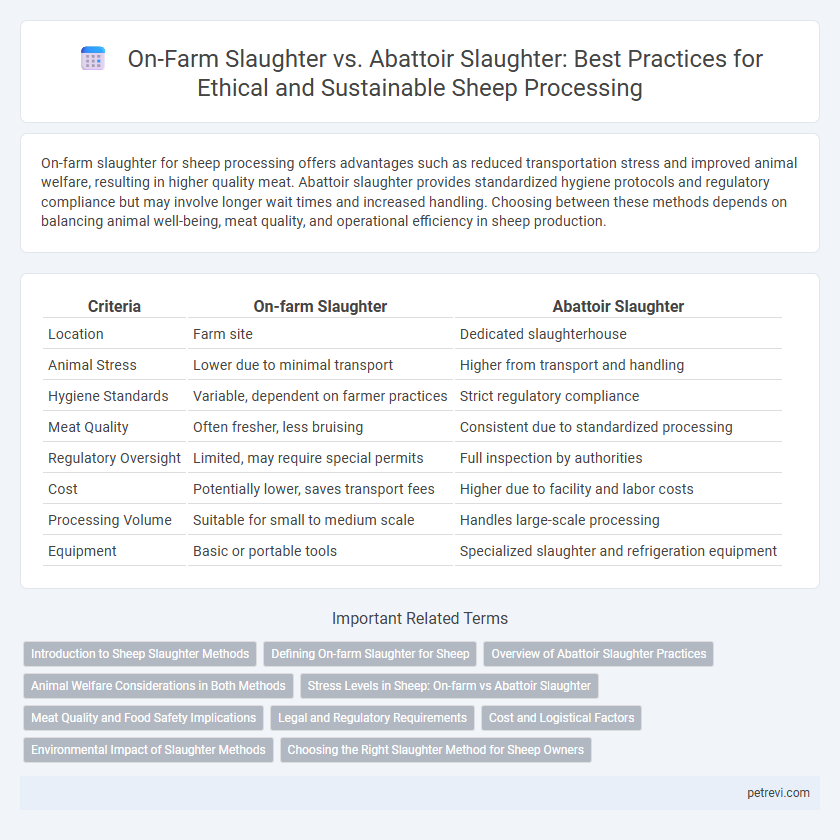On-farm slaughter for sheep processing offers advantages such as reduced transportation stress and improved animal welfare, resulting in higher quality meat. Abattoir slaughter provides standardized hygiene protocols and regulatory compliance but may involve longer wait times and increased handling. Choosing between these methods depends on balancing animal well-being, meat quality, and operational efficiency in sheep production.
Table of Comparison
| Criteria | On-farm Slaughter | Abattoir Slaughter |
|---|---|---|
| Location | Farm site | Dedicated slaughterhouse |
| Animal Stress | Lower due to minimal transport | Higher from transport and handling |
| Hygiene Standards | Variable, dependent on farmer practices | Strict regulatory compliance |
| Meat Quality | Often fresher, less bruising | Consistent due to standardized processing |
| Regulatory Oversight | Limited, may require special permits | Full inspection by authorities |
| Cost | Potentially lower, saves transport fees | Higher due to facility and labor costs |
| Processing Volume | Suitable for small to medium scale | Handles large-scale processing |
| Equipment | Basic or portable tools | Specialized slaughter and refrigeration equipment |
Introduction to Sheep Slaughter Methods
On-farm slaughter of sheep minimizes stress by allowing animals to remain in familiar surroundings, enhancing meat quality through reduced cortisol levels. Abattoir slaughter benefits from standardized processes and regulatory oversight, ensuring consistent hygiene and safety standards. Both methods impact animal welfare and meat characteristics, with choices driven by farm scale, equipment availability, and market demands.
Defining On-farm Slaughter for Sheep
On-farm slaughter for sheep involves the humane killing and initial processing of animals directly on the farm where they are raised, minimizing transportation stress and preserving meat quality. This method allows for immediate handling of the carcass under controlled conditions, often adhering to specific animal welfare and food safety regulations. On-farm slaughter is increasingly preferred for small-scale producers aiming to maintain traceability and reduce environmental impact compared to traditional abattoir processing.
Overview of Abattoir Slaughter Practices
Abattoir slaughter of sheep involves regulated facilities designed to ensure hygiene, animal welfare, and compliance with food safety standards. Practices include stunning methods such as electrical or captive bolt stunning to minimize animal suffering before exsanguination. These controlled environments facilitate efficient carcass handling, inspection by veterinary authorities, and traceability from farm to consumer.
Animal Welfare Considerations in Both Methods
On-farm slaughter of sheep often reduces transport stress and handling-related injuries, improving overall animal welfare by minimizing exposure to unfamiliar environments. In contrast, abattoir slaughter benefits from standardized protocols and monitoring to ensure humane stunning and rapid processing, yet transport and lairage can cause anxiety and physical strain. Both methods require strict adherence to welfare guidelines, but on-farm slaughter allows immediate humane treatment post-harvest, while abattoirs provide controlled environments for consistent welfare oversight.
Stress Levels in Sheep: On-farm vs Abattoir Slaughter
On-farm slaughter of sheep significantly reduces stress levels by minimizing transport and handling, which are major stressors linked to elevated cortisol and adrenaline. Studies show sheep slaughtered on-farm exhibit lower heart rates and fewer stress-induced biochemical markers compared to those processed in abattoirs. Reduced stress enhances meat quality by preventing lactic acid buildup and ensuring better tenderness and flavor.
Meat Quality and Food Safety Implications
On-farm slaughter of sheep minimizes stress-induced biochemical changes, preserving meat tenderness and flavor compared to abattoir slaughter, which often involves transportation stress. Food safety risks increase in on-farm settings due to potential lack of standardized hygiene and pathogen control protocols, whereas abattoirs maintain regulated environments with strict microbial testing to reduce contamination. Choosing between on-farm and abattoir slaughter directly impacts meat quality attributes such as pH, color, and microbial load, influencing both consumer acceptability and foodborne illness risk.
Legal and Regulatory Requirements
On-farm slaughter of sheep must comply with specific national and regional regulations that often emphasize animal welfare standards, hygiene controls, and traceability documentation to ensure food safety. Abattoir slaughter is subject to comprehensive inspections under food safety authorities, including strict adherence to sanitary protocols, mandatory veterinary inspection, and certification processes to meet legal requirements for commercial distribution. Both methods require conformity to animal transport and welfare laws, but abattoirs typically have more rigorous regulatory oversight and established infrastructure for compliance with meat processing legislation.
Cost and Logistical Factors
On-farm slaughter of sheep reduces transportation costs and minimizes stress-related weight loss by keeping animals in familiar environments, offering significant savings in logistics. Abattoir slaughter requires investment in transport, regulatory compliance, and coordination with processing schedules, which can increase operational expenses. Farm-based slaughter can streamline workflow but may necessitate investment in equipment and permits, balancing initial costs against ongoing savings.
Environmental Impact of Slaughter Methods
On-farm slaughter of sheep reduces the carbon footprint by minimizing transportation emissions and energy use associated with abattoirs. Abattoir slaughter typically involves higher resource consumption, including water and electricity, contributing to greater environmental impact. Choosing on-farm slaughter supports sustainable livestock management by decreasing waste and lowering overall greenhouse gas emissions.
Choosing the Right Slaughter Method for Sheep Owners
Sheep owners must evaluate factors such as animal welfare, regulatory compliance, and operational costs when choosing between on-farm slaughter and abattoir slaughter. On-farm slaughter offers greater control over the process, potentially reducing stress for the sheep, while abattoir slaughter ensures adherence to strict hygiene standards and access to professional processing facilities. Understanding local regulations, available infrastructure, and market requirements is essential for optimizing meat quality and profitability in sheep processing.
On-farm Slaughter vs Abattoir Slaughter for Sheep Processing Infographic

 petrevi.com
petrevi.com